Canon LV-7365 User Manual
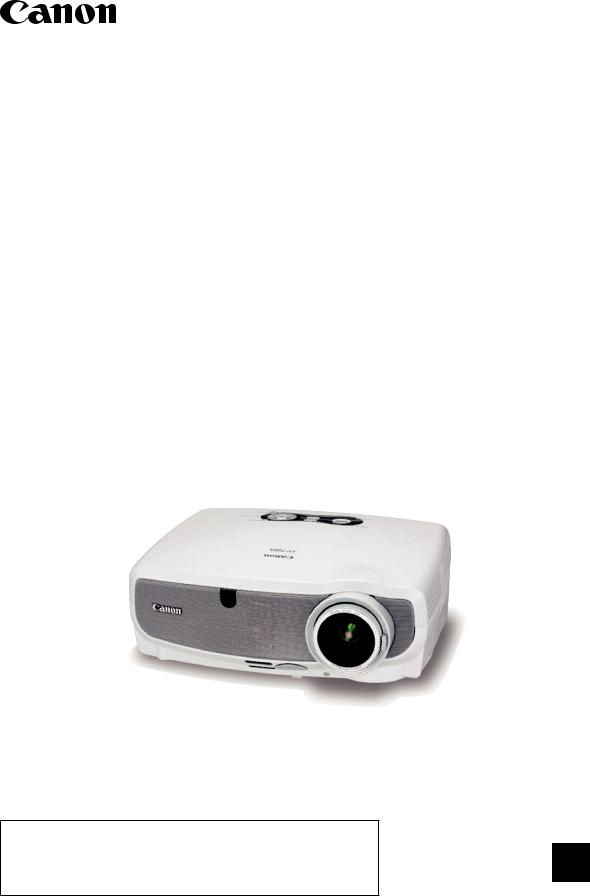
MULTIMEDIA PROJECTOR
LV-7365/LV-7265/LV-7260/LV-X7
User’s Manual
The LV-7365 projector's model name indicated on the projector's label is LV-7365 and LV-7365 (E) respectively.
Both models are referred to as LV-7365 throughout the user's manual except some of the specifications pages.
E
English

Important Information
Safety Cautions
Precautions
Please read this manual carefully before using your Canon LV-7365/LV-7265/LV-7260/LV-X7 projector and keep the manual handy for future reference. Your serial number is located on the bottom of your projector. Record it here:
CAUTION
To turn off main power, be sure to remove the plug from power outlet.
The power outlet socket should be installed as near to the equipment as possible, and should be easily accessible.
CAUTION
TO PREVENT SHOCK, DO NOT OPEN THE CABINET.
NO USER-SERVICEABLE PARTS INSIDE.
REFER SERVICING TO QUALIFIED SERVICE PERSONNEL.
This symbol warns the user that uninsulated voltage within the unit may be sufficient to cause electrical shock. Therefore, it is dangerous to make any kind of contact with any part inside of the unit.
This symbol alerts the user that important information concerning the operation and maintenance of this unit has been provided.
The information should be read carefully to avoid problems.
WARNING: TO PREVENT FIRE OR SHOCK, DO NOT EXPOSE THIS UNIT TO RAIN OR MOISTURE.
DO NOT USE THIS UNIT’S PLUG WITH AN EXTENSION CORD OR IN AN OUTLET UNLESS ALL THE PRONGS CAN BE FULLY INSERTED.
DO NOT OPEN THE CABINET. THERE ARE HIGH-VOLTAGE COMPONENTS INSIDE. ALL SERVICING MUST BE DONE BY QUALIFIED SERVICE PERSONNEL.
Machine Noise Information Regulation - 3. GPSGV,
The highest sound pressure level is less than 70 dB (A) in accordance with EN ISO 7779.
CAUTION
Avoid displaying stationary images for a prolonged period of time.
Doing so can result in these images being temporarily sustained on the surface of the LCD panel.
If this should happen, continue to use your projector. The static background from previous images will disappear.
CAUTION
Do not put the projector on its side when the lamp is turned on.
Doing so may cause damage to the projector.
WARNING TO CALIFORNIA RESIDENTS:
Handling the cables supplied with this product will expose you to lead, a chemical known to the State of California to cause birth defects or other reproductive harm. Wash hands after handling.

Important Information
Federal Communication Commission Notice
Multimedia Projector, Model : LV-7365, LV-7365(E), LV-7265, LV-7260 and LV-X7
This device complies with Part 15 of the FCC Rules. Operation is subject to the following two conditions:
(1) This device may not cause harmful interference, and (2) this device must accept any interference received, including interference that may cause undesired operation.
Note : This equipment has been tested and found to comply with the limits for a Class B digital device, pursuant to part 15 of the FCC Rules. These limits are designed to provide reasonable protection against harmful interference in a residential installation. This equipment generates, uses and can radiate radio frequency energy and, if not installed and used in accordance with the instructions, may cause harmful interference to radio communications. However, there is no guarantee that interference will not occur in a particular installation. If this equipment does cause harmful interference to radio or television reception, which can be determined by turning the equipment off and on, the user is encouraged to try to correct the interference by one or more of the following measures :
–Reorient or relocate the receiving antenna.
–Increase the separation between the equipment and receiver.
–Connect the equipment into an outlet on a circuit different from that to which the receiver is connected.
–Consult the dealer or an experienced radio/TV technician for help.
The cable with the ferrite core provided with the projector must be used with this equipment in order to comply with Class B limits in Subpart B of Part 15 of the FCC rules.
Use of shielded cable is required to comply with class B limits in Subpart B of Part 15 of FCC Rules.
Do not make any changes or modifications to the equipment unless otherwise specified in the instructions. If such changes or modifications should be made, you could be required to stop operation of the equipment.
Canon U.S.A., Inc.
One Canon Plaza, Lake Success, NY 11042, U.S.A.
Tel No. (516)328-5600
Canadian Radio Interference Regulations
This Class B digital apparatus complies with Canadian ICES-003.
Réglementation canadienne sur les intérferences radio
Cet appareil numérique de la classe B est conforme à la norme NMB-003 du Canada.
European Union (and EEA) only.
This symbol indicates that this product is not to be disposed of with your household waste, according to the WEEE Directive (2002/96/EC) and your national law. This product should be handed over to a designated collection point, e.g., on an authorized one-for-one basis when you buy a new similar product or to an authorized collection site for recycling waste electrical and electronic equipment (EEE). Improper handling of this type of waste could have a possible negative impact on the environment and human health due to potentially hazardous substances that are generally associated with EEE. At the same time, your cooperation in the correct disposal of this product will contribute to the effective usage of natural resources. For more information about where you can drop off your waste equipment for recycling, please contact your local city office, waste authority, approved WEEE scheme or your household waste disposal service.
Your cooperation in the correct disposal of this product will contribute to the effective usage of natural resources and will avoid incurring administrative sanctions according to art.
50 and following of Italian legislative decree 22/97.
For more information regarding return and recycling of WEEE products, please visit www.canon-europe.com/environment.
(EEA: Norway, Iceland and Liechtenstein)
ii
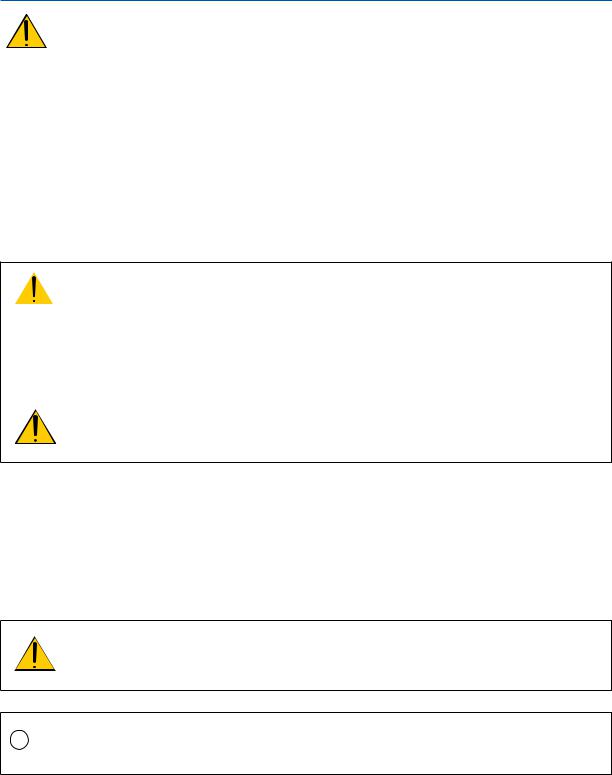
Important Information
LAMP HANDLING
PRECAUTIONS
This projector uses a high-pressure mercury lamp which must be handled carefully and properly as mentioned below.
•A lamp may explode with a loud sound or burn out due to a shock, scratch, or expiration of lifetime.
•The lamp life may differ from lamp to lamp and according to the environment of use. There is not guarantee of the same lifetime for each lamp. Some lamps may fail or terminate their life in a shorter period of time than other similar lamps.
•A lamp gradually becomes darker with time of use.
•If the projector indicates that the lamp should be replaced (i.e., the LAMP indicator blinks red rapidly), chances of explosion become higher. Replace the lamp with a new one immediately.
•Always keep your face away from the exhaust vent so that you do not suffer from the gas and broken shards of the lamp.
 IF A LAMP EXPLODES
IF A LAMP EXPLODES
If a lamp explodes, the gas and broken shards may scatter inside the projector and they may come out of the exhaust vent. The gas contains toxic mercury.
Open windows and doors for ventilation.
If you inhale the gas or the shards of the broken lamp enter your eyes or mouth, consult the doctor immediately.
If a lamp explodes, its shards may scatter inside the projector. Ask the Canon service representative to clean and check the inside of the projector and replace the lamp.
DISPOSAL OF WASTE LAMP
Dispose of the mercury lamp of the projector according to the local regulation just like the fluorescent lamp.
Lamp Replacement
•To replace the lamp, follow all instructions provided on page 58.
•Be sure to replace the lamp when the message [Replace with the new lamp.] appears. If you continue to use the lamp after the lamp has reached the end of its usable life, the lamp bulb may shatter, and pieces of glass may be scattered in the lamp case. Do not touch them as the pieces of glass may cause injury.
If this happens, contact your dealer for lamp replacement.
CAUTION
When removing the lamp from a ceiling-mounted projector, make sure that no one is under the projector. Glass fragments could fall if the lamp has been burned out.
NOTE FOR CUSTOMERS IN THE US
Hg LAMP(S) INSIDE THIS PRODUCT CONTAIN MERCURY AND MUST BE RECYCLED OR DISPOSED OF ACCORDING TO LOCAL, STATE OR FEDERAL LAWS.
iii
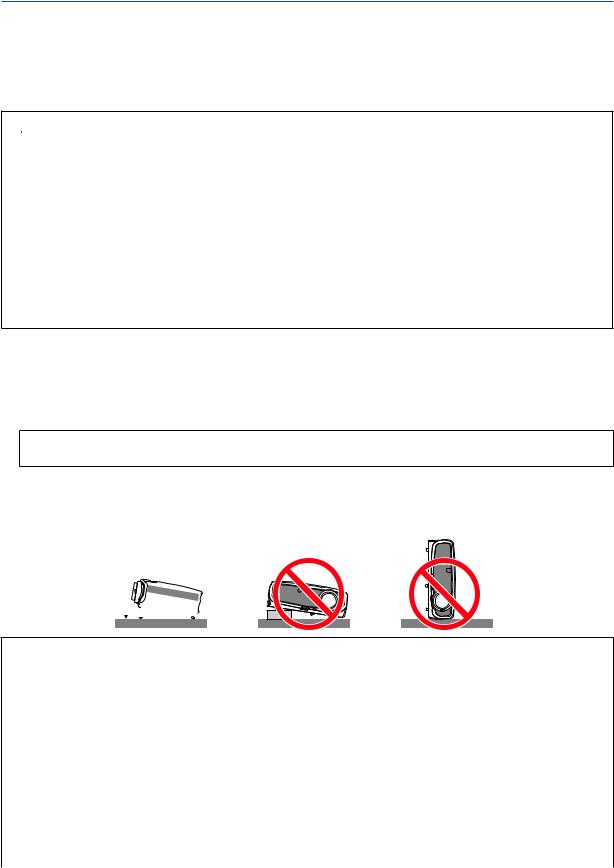
Important Information
For UK only: In UK, a BS approved power cord with moulded plug has a Black (five Amps) fuse installed for use with this equipment. If a power cord is not supplied with this equipment please contact your supplier.
Important Safeguards
These safety instructions are to ensure the long life of your projector and to prevent fire and shock. Please read them carefully and heed all warnings.
 Installation
Installation
•Do not place the projector in the following conditions:
-on an unstable cart, stand, or table.
-near water, baths or damp rooms.
-in direct sunlight, near heaters or heat radiating appliances.
-in a dusty, smoky or steamy environment.
-on a sheet of paper or cloth, rugs or carpets.
•If you wish to have the projector installed on the ceiling:
-Do not attempt to install the projector yourself.
-The projector must be installed by qualified technicians in order to ensure proper operation and reduce the risk of bodily injury.
-In addition, the ceiling must be strong enough to support the projector and the installation must be in accordance with any local building codes.
-Please consult your dealer for more information.
Do Not Use in the Following Environments
Do not install the projector in a humid or dusty place or a place where there is much oily smoke or cigarette smoke. Optical parts such as a lens and mirror are stained, resulting in poor picture.
Do not use the projector in a place where the temperature becomes very high or low.
Operating temperature: +5°C to +40°C Storage temperature: -10°C to +50°C (Quiet mode selected automatically at 95°F to 104°F / 35°C to 40°C)
Place the projector in a horizontal position
The tilt angle of the projector should not exceed 10 degrees, nor should the projector be installed in any way other than the desktop and ceiling mount, otherwise lamp life could decrease dramatically.
10˚


 Fire and Shock Precautions
Fire and Shock Precautions
•Ensure that there is sufficient ventilation and that vents are unobstructed to prevent the build-up of heat inside projector. Allow at least 1 m (3.3') of space between your projector and a wall.
•Do not try to touch the ventilation outlet on the left front (when seen from the front) as it can become heated the projector is turned on and immediately after the projector is turned off.
•Prevent foreign objects such as paper clips and bits of paper from falling into your projector. Do not attempt retrieve any objects that might fall into your projector. Do not insert any metal objects such as a wire or screwdriver into your projector. If something should fall into your projector, disconnect it immediately and have the object removed by a qualified service personnel.
•Do not place any objects on top of the projector.
•Do not touch the power plug during a thunderstorm. Doing so can cause electrical shock or fire.
•The projector is designed to operate on power source voltages indicated on indicated in the rating label on the projector. Ensure that your power fits this requirement before attempting to use your projector.
iv

Important Information
•Do not look into the lens while the projector is on. Serious damage to your eyes could result.
•Keep any items such as magnifying glass out of the light path of the projector. The light being projected from the lens is extensive, therefore any kind of abnormal objects that can redirect light coming out of the lens, can cause unpredictable outcome such as fire or injury to the eyes.
•Do not cover the lens with the black lens cap or equivalent while the projector is on. Doing so can lead to melting the cap and possibly burning your hands due to the heat emitted from the light output.
•Do not place any objects, which are easily affected by heat, in front of the projector lens or a projector exhaust
Doing so could lead to the object melting or getting your hands burned from the heat that is emitted from the output and exhaust.
•Handle the power cord carefully. A damaged or frayed power cord can cause electric shock or fire.
-Do not use any power cords than the supplied one.
-Do not bend or tug the power cord excessively.
-Do not place the power cord under the projector, or any heavy object.
-Do not cover the power cord with other soft materials such as rugs.
-Do not heat the power cord
-Do not handle the power plug with wet hands.
•Turn off the projector, unplug the power cord and have the projector serviced by a qualified service personnel under the following conditions:
-When the power cord or plug is damaged or frayed.
-If liquid has been spilled into the projector, or if it has been exposed to rain or water.
-If the projector does not operate normally when you follow the instructions described in this user's manual.
-If the projector has been dropped or the cabinet has been damaged.
-If the projector exhibits a distinct change in performance, indicating a need for service.
•Disconnect the power cord and any other cables before carrying the projector
•Turn off the projector and unplug the power cord before cleaning the cabinet or replacing the lamp.
•Turn off the projector and unplug the power cord if the projector is not to be used for an extended period of time.
CAUTION
•Do not try to touch the ventilation outlet on the left side (when seen from the front) as it can become heated while the projector is turned on.
•Do not use the tilt-foot for purposes other than originally intended. Misuses such as gripping the tilt-foot or hanging on the wall can cause damage to the projector.
•Select [High] in Fan mode if you continue to use the projector for consecutive days. (From the menu, select [Setup]→ [Options] → [Fan mode] → [High].) Fan noise increases noticeably in High mode.
•Do not turn off the AC power by pressing the main power switch or by unplugging the power cord when the projector is powered on.
•Do not turn off the AC power for 60 seconds after the lamp is turned on and while the POWER indicator is blinking green. Doing so could cause premature lamp failure.

Important Information
CARRYING/TRANSPORTING THE PROJECTOR
This projector is a precision machine. Do not give a strong shock to the projector or turn it down.
Thoroughly read "Use Caution When Carrying or Transporting the Projector" below and install the lens cap before carrying the projector. When transporting the projector by train or airplane, use a highly crashworthy transport case.
Use Caution When Carrying or Transporting the Projector
The carrying bag is intended for protection from dust and scratches on the surface of the cabinet, and it is not designed to protect the projector from external shocks. When carrying the projector with it put in the carrying bag, do not give a shock to it, drop it, or place anything on it.
Do not transport the projector through a courier or transport service with the carrying bag. The projector can damage.
 Remote Control Precautions
Remote Control Precautions
•Handle the remote control carefully.
•If the remote control gets wet, wipe it dry immediately.
•Avoid excessive heat and humidity.
•Do not heat, take apart, or throw batteries into fire.
•If you will not be using the remote control for a long time, remove the batteries.
•Ensure that you have the batteries' polarity (+/-) aligned correctly.
•Do not use new and old batteries together, or use different types of batteries together.
•Dispose of used batteries according to your local regulations.
About [High altitude] mode
LV-7365
•Set [Fan mode] to [High altitude] when using the projector at altitudes approximately 5500 feet/1600 meters or higher.
Using the projector at altitudes approximately 5500 feet/1600 meters or higher without setting to [High altitude] can cause the projector to overheat and the protector could shut down. Furthermore, the projector could not turn on due to the increased temperature of the lamp after power off. If these happen, wait a couple minutes and turn on the projector.
•Using the projector at altitudes less than approximately 5500 feet/1600 meters and setting to [High altitude] can cause the lamp to overcool, causing the image to flicker. Switch [Fan mode] to [Auto].
•Using the projector at altitudes approximately 5500 feet/1600 meters or higher can shorten the life of optical components such as the lamp.
LV-7265/LV-7260/LV-X7
•On LV-7265, LV-7260, and LV-X7 [Fan mode] menu does not have [High altitude]. Select [High] in [Fan mode] if you use the projector at a high altitude or under low atmospheric pressure.
vi

Table of Contents
Important Information .......................................................................................... |
i |
1. Introduction ......................................................................................................... |
1 |
What's in the Box?......................................................................................................... |
1 |
Introduction to the Projector.......................................................................................... |
2 |
Part Names of the Projector.......................................................................................... |
4 |
Top Features............................................................................................................ |
6 |
Terminal Panel Features.......................................................................................... |
7 |
Part Names of the Remote Control............................................................................... |
8 |
Battery Installation............................................................................................ |
10 |
Remote Control Precautions............................................................................. |
10 |
Operating Range for Wireless Remote Control................................................ |
10 |
2. Installation and Connections .................................................................. |
11 |
Setting Up the Screen and the Projector..................................................................... |
12 |
Selecting a Location (LV-7365/LV-7265)............................................................... |
12 |
Throw Distance and Screen Size..................................................................... |
12 |
Selecting a Location (LV-7260/LV-X7)................................................................... |
13 |
Throw Distance and Screen Size..................................................................... |
13 |
Making Connections.................................................................................................... |
15 |
Enabling the computer’s external display.............................................................. |
15 |
Connecting Your PC or Macintosh Computer (LV-7365/LV-7265)........................ |
15 |
Using Two Analog COMPUTER Inputs Simultaneously (LV-7365/LV-7265)... |
16 |
When Viewing a DVI Digital Signal (LV-7365/LV-7265)................................... |
17 |
Connecting Your PC or Macintosh Computer (LV-7260/LV-X7)............................ |
18 |
Connecting an External Monitor............................................................................. |
19 |
Connecting Your DVD Player with Component Output.......................................... |
20 |
Connecting Your VCR or Laser Disc Player.......................................................... |
21 |
Connecting a Digital Video Signal (LV-7365/LV-7265).......................................... |
22 |
Connecting the Supplied Power Cord.................................................................... |
23 |
3. Projecting an Image (Basic Operation) ............................................. |
24 |
Turning on the Projector.............................................................................................. |
24 |
Note on Startup Screen (Menu Language Select screen)..................................... |
25 |
Selecting a Source...................................................................................................... |
26 |
Adjusting the Picture Size and Position....................................................................... |
27 |
Correcting Keystone Distortion.................................................................................... |
29 |
Automatically Optimizing on RGB Image.................................................................... |
31 |
Turning Up or Down Volume....................................................................................... |
31 |
Turning off the Projector.............................................................................................. |
32 |
After Use...................................................................................................................... |
33 |
vii

|
Table of Contents |
4. Convenient Features .................................................................................... |
34 |
Turning Off the Image and Sound............................................................................... |
34 |
Freezing a Picture....................................................................................................... |
34 |
Enlarging and Moving a Picture................................................................................... |
34 |
Using the Remote Mouse Receiver (LV-7365/LV-7265/LV-7260)............................... |
35 |
Preventing the Unauthorized Use of the Projector...................................................... |
37 |
5. Using On-Screen Menu ............................................................................... |
40 |
Using the Menus.......................................................................................................... |
40 |
Menu Elements............................................................................................................ |
42 |
List of Menu Items....................................................................................................... |
43 |
Menu Descriptions & Functions [Image adjustment]................................................... |
45 |
Menu Descriptions & Functions [Display settings]....................................................... |
46 |
Menu Descriptions & Functions [Setup]...................................................................... |
48 |
Menu Descriptions & Functions [Information].............................................................. |
54 |
Menu Descriptions & Functions [Reset]...................................................................... |
55 |
6. Maintenance ..................................................................................................... |
56 |
Cleaning or Replacing the Filter................................................................................. |
56 |
Cleaning the Cabinet and the Lens............................................................................ |
57 |
Replacing the Lamp.................................................................................................... |
58 |
7. Appendix ............................................................................................................. |
61 |
Troubleshooting.......................................................................................................... |
61 |
Specifications............................................................................................................. |
64 |
Cabinet Dimensions................................................................................................... |
66 |
Pin Assignments of D-Sub ANALOG Input Connector............................................... |
67 |
Compatible Input Signal List....................................................................................... |
68 |
Relationship between Screen Size and Projection Distance...................................... |
69 |
PC Control Codes and Cable Connection.................................................................. |
71 |
Troubleshooting Check List........................................................................................ |
72 |
viii
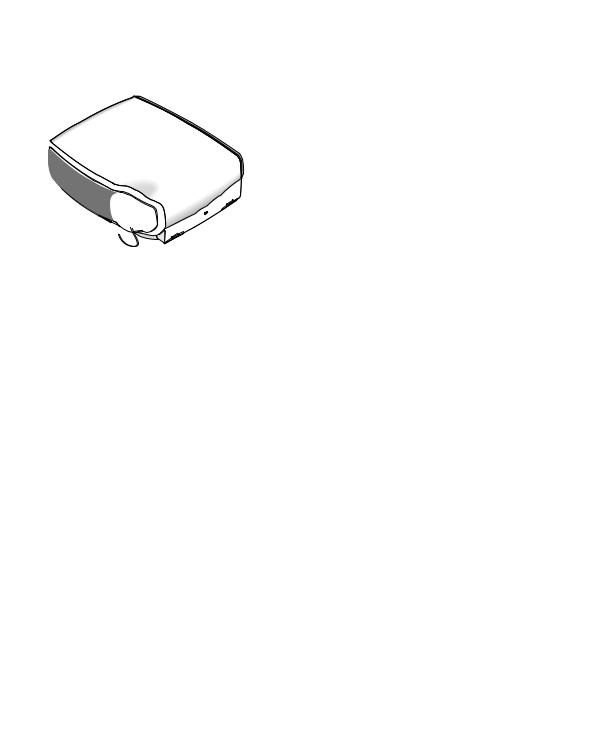
1. Introduction
What's in the Box?
Make sure your box contains everything listed. If any pieces are missing, contact your dealer. Please save the original box and packing materials if you ever need to ship your projector.
Projector
KCAB
UEN M
TUPIN OTUA
WOP
GIN
NRAW
P MAL
Soft case
Lens cap
|
L- |
|
CLICK |
|
VOL |
FREEZE |
PAGE |
D. |
|
|
ZOOM |
RD- |
|
428E |
|
|
PO |
|
|
|
|
IM |
WER |
|
|
ASPECT |
AGE |
|
|
FO. |
NPUT |
|
|||
|
I |
|
IN |
|
ME |
|
|
AUTO |
|
NU |
|
|
PC |
|
|
NO |
SHOW |
|
|
|
|
|
|
|
|
B |
R- |
ACK |
CLICK |
|
AC power cord |
VGA cable |
Remote control |
Batteries (AAA 2) |
(4.5 m / 14.8’) |
(1.8 m / 5.9’) |
|
|
|
[7N520068] |
|
|
|
Quick |
|
|
Start |
|
|
|
Guide |
|
|
|
Important |
|
|
|
Information |
|
|
|
|
Quick Start Guide |
CD-ROM |
Warranty |
|
Important Information |
User’s manual |
|
For LV-7365/LV-7265/LV-7260 For LV-7365/LV-7265
Remote mouse receiver |
DVI to VGA adapter |
(10 cm / 0.3’) |
|
(7N900563) |
|

1. Introduction
Introduction to the Projector
This section introduces you to your new projector and describes the features and controls.
Congratulations on Your Purchase of The Projector
The LV-7365/LV-7265/LV-7260/LV-X7 is one of the very best projectors available today. The projector enables you to project precise images up to 300 inches across (measured diagonally) from your PC or Macintosh computer (desktop or notebook), VCR, DVD player, document camera, or a laser disc player.
You can use the projector on a tabletop or cart, from behind a screen, or permanently mounted on a ceiling*1. The remote control can be used wirelessly.
*1 Do not attempt to mount the projector on a ceiling yourself.
The projector must be installed by qualified technicians in order to ensure proper operation and reduce the risk of bodily injury.
In addition, the ceiling must be strong enough to support the projector and the installation must be in accordance with any local building codes. Please consult your dealer for more information.
Features you'll enjoy:
•Auto vertical keystone correction (LV-7365/LV-7265).
•Built-in Wall Color Correction presets provide for adaptive color correction when projecting onto non-white screen material.
•Quick start & quick cool down.
Eight seconds after turning on the power, the projector is ready to display PC or video images*.
Powering down; The fans stop 30 seconds after turning off the power from the remote control or cabinet control panel. The projector can be put away immediately after the projector is powered down.
Also, the main power of the projector can be turned off by pressing the main power switch or unplugging the power cord even during the cool down period after the projector is turned off.
* If you turn on the projector immediately after the lamp is turned off or when the temperature is high, the fans runs without displaying an image for some time and then the projector will display the image.
•DVI input connector (DVI-I 29 Pin) with HDCP compatible (LV-7365/LV-7265)
•HDTV (1080i, 720p) and SDTV (576p, 480p) compatibility.
•Color Management system.
•Short focal length lens.
•Display popular wide screen and full screen aspect ratios - 16:9 and 4:3.
•Built-in speaker for an integrated audio solution.
•High resolution display - up to UXGA compatible, XGA native resolution.
•Multiple video mode selections (depending on your source).
•Security feature prevents unauthorized individuals from displaying images.
•You can control the projector with a PC or control system using the PC Control port (SERVICE PORT).
•Easy set up and operation.
•The contemporary cabinet design is light, compact and complements any office, boardroom Auditorium.
•You can use the supplied wireless remote control and remote mouse receiver to operate your PC mouse from across the room. The remote mouse receiver supports almost any PC using a USB connection (LV-7365, LV-7265 and LV-7260).

1. Introduction
About this user's manual
The fastest way to get started is to take your time and do everything right the first time. Take a few minutes now to review the user's manual. This may save you time later on. At the beginning of each section of the manual you'll find an overview. If the section doesn't apply, you can skip it.
•Microsoft, Windows, Windows Vista, and PowerPoint are trademarks or registered trademarks of Microsoft Corporation in the U.S. and other countries.
•Macintosh, Mac, and PowerBook are trademarks of Apple Inc., registered in the U.S. and other countries.
•VESA is a registered trademark of Video Electronics Standards Association.
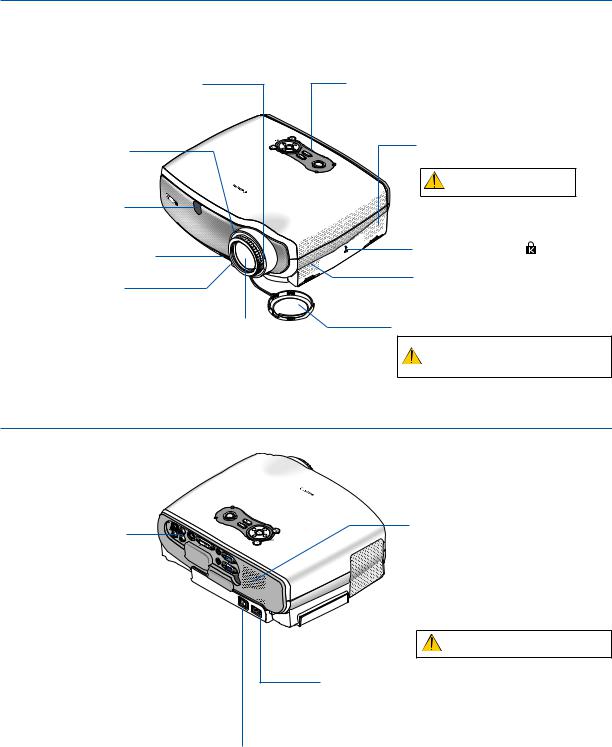
1. Introduction
Part Names of the Projector
Front/Top
Zoom Lever |
|
|
Controls |
|
(See page 28) |
|
|
(See page 6) |
|
|
KCAB |
|
|
|
|
ENOTSY |
|
Ventilation (inlet) / Filter Cover |
|
|
LOV |
|
||
Focus Ring |
UNEM |
|
|
|
TOUA |
|
(See page 56) |
|
|
|
R |
P |
|
|
(See page 28) |
TUPNI |
|
|
|
EWOP |
MAL |
Do not block this vent. |
||
|
|
GNIN |
||
|
|
RAW |
|
|
|
|
|
Troubles or fire can result. |
|
Remote sensor |
|
|
Two filters on LV-7365/LV-7265/LV-7260 |
|
(See page 10) |
|
|
One filter on LV-X7 |
|
Adjustable Tilt Foot Lock Button |
|
|
Built-in Security Slot ( |
)* |
|
|
|
|
|
(See page 27) |
|
|
Ventilation (inlet) |
|
Adjustable Tilt Foot |
|
|
|
|
|
|
|
|
|
(See page 27) |
|
|
|
|
Lens |
|
|
Lens Cap |
|
|
|
|
Be sure to remove the lens cap during |
|
|
|
|
projection. The cap can deform or fire |
|
|
|
|
can occur. |
|
*This security slot supports the MicroSaver ® Security System. MicroSaver ® is a registered trademark of Kensington Microware Inc. The logo is trademarked and owned by Kensington Microware Inc.
Rear
WARNING
Terminal Panel |
Monaural Speaker |
|
(LV-7365/LV-7265: 5W) |
||
(See page 7) |
||
(LV-7260/LV-X7: 1W) |
||
|
Remote sensor 







(LV-7365/LV-7265) (See page 10)
 Ventilation (outlet)
Ventilation (outlet)
Heated air is exhausted from here.
Do not block this vent. Troubles or fire can result.
AC Input
Connect the supplied power cord’s two-pin plug here, and plug the other end into an active wall outlet. (See page 23)
Main Power Switch
When you plug the supplied power cord into an active wall outlet and turn on the Main Power, the POWER indicator turns orange and the projector is in standby mode.
(See page 24)
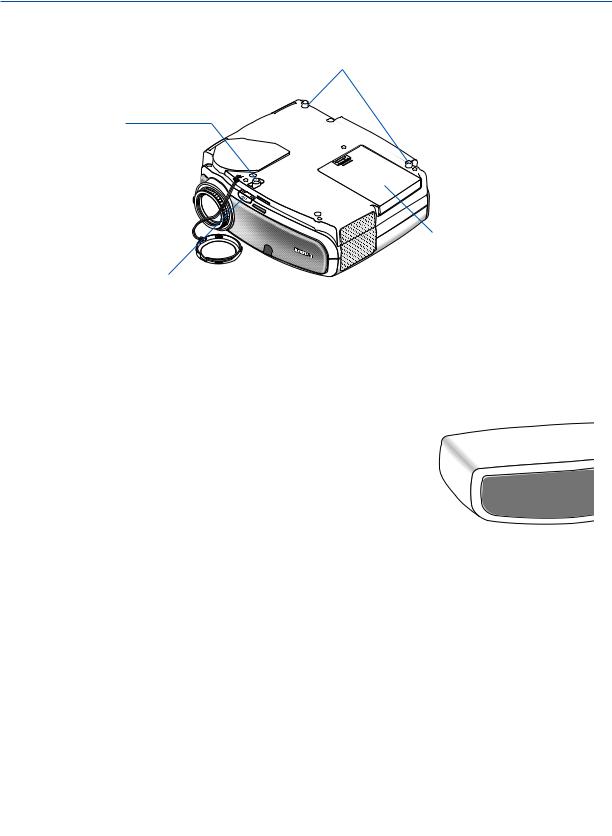
1. Introduction
Bottom
Rear Foot (Left / Right)
Adjustable Tilt Foot (See page 27)
Lamp Cover (See page 58)
Adjustable Tilt Foot Lock Button (See page 27)
HINT: The Canon logo is on the panel of the projector cabinet . When projecting an image with the projector hung from the ceiling, turn the Canon logo upside down.
To turn the logo upside down, follow the steps below.
1. Push one end of the logo gently.
The other end will pop up slightly.
• The right drawing shows the part “C” is pressed gently.
• The part “n” on the other end will pop up.
2. Push and hold the end of the logo gently and rotate the logo by holding the other end.
• The right drawing shows that with the part “C” pressed the logo is rotated by holding the part “n” on the other end.
3. Release your hold and turn the logo upside down.

1. Introduction
Top Features
|
|
|
5 |
3 WARNING |
|
|
|
O |
W |
|
|
E |
R |
|
|
P |
|
INPUT |
|
|
|
|
|
|
|
|
AUTO PC |
4 LAMP 
1 2 6
1. POWER Button ( )
)
Use this button to turn the power on and off when the main power is supplied and the projector is in standby mode.
To turn on the projector, press and hold this button for about 1 second. To turn off the projector, press this button twice.
2.POWER Indicator
When this indicator is green, the projector is on; when this indicator is orange, it is in standby mode. See the Power Indicator section on page 61 for more details.
3.WARNING Indicator
If this light blinks red rapidly, it indicates that an error has occurred, the lamp cover is not attached properly or the projector has overheated. If this light remains orange, it indicates that you have pressed a cabinet key while the Key lock is enabled. See the WARNING Indicator section on page 61 for more details.
4.LAMP Indicator
If this light blinks red rapidly, it's warning you that the lamp has reached the end of its usable life. After this light appears, replace the lamp as soon as possible (See page 58). If this is lit green continually, it indicates that the lamp mode is set to Quiet. See the Lamp Indicator section on page 61 for more details.
5.INPUT Button
Selecting from INPUT List
Press and quickly release the INPUT button to display the INPUT list. Each time the INPUT button is pressed, the input source will change as follows:
8 7
MENU
 KEYSTONE
KEYSTONE
VOL |
VOL |
- |
+ |
BACK
9 10
Detecting the Signal Automatically
Press and hold the INPUT button for a minimum of 2 seconds, the projector will search for the next available input source. Each time you press and hold the INPUT button for a minimum of 2 seconds, the input source will change as follows:
Computer 1* → Computer 2 (Digital)* → Computer 2 (Analog)* → VIDEO → S-VIDEO → Computer 1* → ...
* LV-7260/LV-X7: Computer → VIDEO → S-VIDEO → Computer → ...
6.AUTO PC Button
Use this button to adjust an analog RGB source for an optimal picture. See page 31.
7.MENU Button
Displays the menu. See page 40, 41.
8.SELECT 


 / VOL (+/–) Buttons
/ VOL (+/–) Buttons
See page 40.

 : Use these buttons to select the menu of the item you wish to adjust.
: Use these buttons to select the menu of the item you wish to adjust.
When no menus appear, these buttons work as a keystone control. See page 29.

 : Use these buttons to change the level of a selected menu item. A press of the
: Use these buttons to change the level of a selected menu item. A press of the  button executes the selection. When no menus appear, these buttons work as a volume control. See page 31.
button executes the selection. When no menus appear, these buttons work as a volume control. See page 31.
9.OK Button
Executes your menu selection and activates items selected from the menu.
Computer 1* → Computer 2 (Digital)* → Computer 2 (Analog)* → VIDEO → S-VIDEO → Computer 1* → ...
To display the selected source, press the OK button or allow 2 seconds to elapse.
10.BACK Button
Pressing this button will return to the previous menu.
While you are in the main menu, pressing this button will close the menu.

1. Introduction
Terminal Panel Features 7 8 9 |
2 |
3 |
1 |
LV-7365/LV-7265
AUDIO IN |
ANALOG IN-1 |
|
S-VIDEO |
L |
|
|
|
|
|
|
|
|
|
|
IN |
|
DIGITAL IN / |
|
|
|
|
SERVICE PORT |
AUDIO OUT |
|
|
|
|
ANALOG IN-2 |
|
||
|
VIDEO |
R |
|
|
|
|
|
|
|
|
|
|
IN |
|
|
|
|
|
|
AUDIO IN |
|
|
|
|
6 |
|
|
5 |
4 |
LV-7260/LV-X7 |
7 |
9 |
|
|
|
|
|
|
|
|
ANALOG IN |
|
S-VIDEO |
L |
|
|
|
|
|
|
|
|
|
|
IN |
|
|
|
|
|
|
SERVICE PORT |
|
|
|
|
VIDEO |
R |
|
|
|
|
|
|
|
|
|
|
IN |
|
|
|
|
|
|
AUDIO IN |
|
|
|
|
6 |
8 |
4 |
|
1 |
1.Computer 1 Input Connector [ANALOG IN-1] (Computer Input Connector [ANALOG IN] on LV-7260/LV-X7) (Mini D-Sub 15 Pin)
Connect your computer or other analog RGB equipment such as IBM compatible or Macintosh computers. Use the supplied VGA cable to connect to your computer. This also serves as a component input connector that allows you to connect a component video output of component equipment such as a DVD player. See page 15, 18, 20.
2.Computer 2 Input Connector [DIGITAL IN/ANALOG IN-2] (DVI-I 29 Pin) (LV-7365/LV-7265)
5.AUDIO OUT Mini Jack (Stereo Mini) (LV-7365/LV-7265)
You can use this jack to output sound from the currently selected source (COMPUTER, VIDEO or S-VIDEO). Output sound level can be adjusted in accordance with the sound level of the internal speaker. Note that this cannot be used as a headphone jack.
(When audio equipment is connected, the projector speaker is disabled.)
When a cable mini-plug is inserted into this jack, both the right and left audio signals are not mixed, but separate. For example, when a cable mini-plug is inserted into the left AUDIO IN jack only, only left sound is output.
Connect your computer or other analog RGB equip- |
6. |
VIDEO IN Connector (RCA) |
|
ment such as IBM compatible or Macintosh comput- |
|
Connect a VCR, DVD player, laser disc player, or |
|
ers. |
|
document camera here to project video. See page 21. |
|
Use the supplied VGA cable to connect to your com- |
|
|
|
puter. This also serves as a component input connec- |
7. |
S-VIDEO IN Connector (Mini DIN 4 Pin) |
|
tor that allows you to connect a component video out- |
|
Here is where you connect the S-Video input from |
|
put of component equipment such as a DVD player. |
|
an external source like a VCR. See page 21. |
|
See page 15, 16. |
|
|
|
|
NOTE: S-Video provides more vivid color and higher reso- |
||
|
|
lution than the traditional composite video format. |
|
3. AUDIO IN Mini Jack (Stereo Mini) (LV-7365/LV-7265)
This is where you connect the audio output from your computer or DVD player when connected to the COMPUTER input. A commercially available audio cable is required. See page 15, 20.
4.Monitor Output Connector [ ] (Mini D-Sub 15 Pin)
] (Mini D-Sub 15 Pin)
You can use this connector to loop your computer image to an external monitor from the RGB input source. This connector outputs RGB signal in standby mode. See page 19.
8.AUDIO IN Jacks L/R (RCA)
These are your left and right channel audio inputs for stereo sound from a Video/S-Video source.
These jacks support an analog RGB audio source on LV-7260/LV-X7. See page 18, 21.
9.SERVICE PORT (Mini DIN 8 Pin)
Use this port to connect a PC or control system to control the projector via an optional RS-232C serial cable (LV-CA34). If you are writing your own program, typical PC control codes are on page 71.
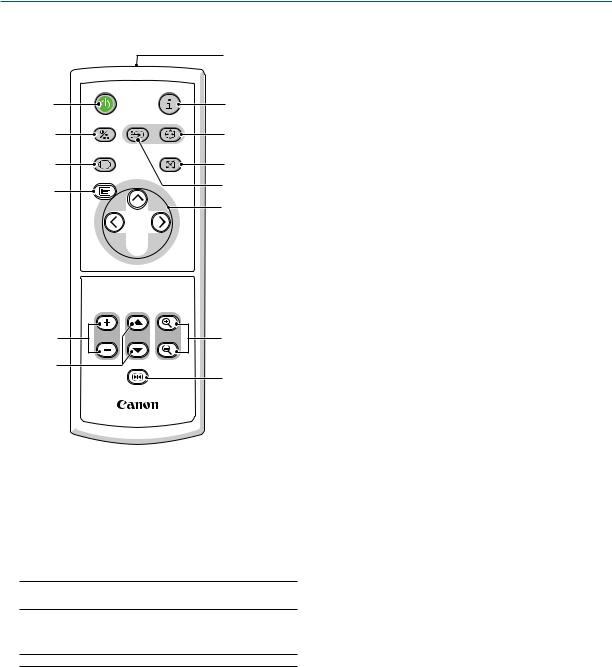
1. Introduction
Part Names of the Remote Control
|
1 |
|
POWER |
INFO. |
|
2 |
3 |
|
IMAGE |
INPUT AUTO PC |
|
4 |
6 |
|
ASPECT |
NO SHOW |
|
7 |
8 |
|
9 |
5 |
|
10 |
||
|
11


 12
12
13


 14
14
15 |
17 |
16 |
18 |
|
|
|
RD-428E |
1.Infrared Transmitter
Direct the remote control toward the remote sensor on the projector cabinet.
2.POWER Button
When the main power is on, you can use this button to turn your projector on.
NOTE: To turn on the projector, press and hold the POWER button for about 1 second.
You can use this button to turn your projector off.
NOTE: To turn off the projector, press this button twice.
3.INFO. Button
Provides the information on the current signal and projector settings. See page 54.
4.IMAGE Button
Press this button to display the Image adjustment menu to adjust Image mode, Contrast, Brightness, Sharpness, Color level and Color balance. See pages 45 to 46.
5.INPUT Button
Selecting from INPUT List
Press and quickly release the INPUT button to display the INPUT list. Each time the INPUT button is pressed, the input source will change as follows:
Computer 1* → Computer 2 (Digital)* → Computer 2 (Analog)* → VIDEO → S-VIDEO → Computer 1* → ...
To display the selected source, press the OK button or allow 2 seconds to elapse.
Detecting the Signal Automatically
Press and hold the INPUT button for a minimum of 2 seconds, the projector will search for the next available input source. Each time you press and hold the INPUT button for a minimum of 2 seconds, the input source will change as follows:
Computer 1* → Computer 2 (Digital)* → Computer 2 (Analog)* → VIDEO → S-VIDEO → Computer 1* → ...
* LV-7260/LV-X7: Computer → VIDEO → S-VIDEO → Computer → ...
6.AUTO PC Button
Use this button to adjust an analog RGB source for an optimal picture. See page 31.
7.ASPECT Button
Press this button once to display the Aspect select menu. Keep pressing will change aspect ratios. See page 46.
8.NO SHOW Button
This button turns off the image and sound for a short period of time. Press again to restore the image and sound. See page 34.
9.MENU Button
Displays the menu for various settings and adjustments. See page 40, 41.
10.SELECT 


 (Mouse) Button
(Mouse) Button
See page 40.

 : Use these buttons to select the menu of the item you wish to adjust.
: Use these buttons to select the menu of the item you wish to adjust.

 : Use these buttons to change the level of a selected menu item. A press of the
: Use these buttons to change the level of a selected menu item. A press of the  button executes the selection.
button executes the selection.
When an image is magnified, the SELECT 


 button moves the image. See page 34.
button moves the image. See page 34.
This button also works as a computer mouse when the supplied remote mouse receiver is connected with your computer. See page 36. (This button cannot be used as a computer mouse for LV-X7.)

1. Introduction
|
1 |
|
POWER |
INFO. |
|
2 |
3 |
|
IMAGE |
INPUT AUTO PC |
|
4 |
6 |
|
ASPECT |
NO SHOW |
|
7 |
8 |
|
9 |
5 |
|
10 |
||
|
11


 12
12
13


 14
14
15 |
17 |
16 |
18 |
|
|
|
RD-428E |
11.OK Button
Use this button to enter your menu selection. It works the same way as the OK button on the cabinet. See page 6.
12.BACK Button
It works the same way as the BACK button on the cabinet. See page 6.
13.L-CLICK Button
(This button cannot be used for LV-X7.)
This button works as the mouse left button when the supplied remote mouse receiver is connected with your computer. See page 36.
14.R-CLICK Button
(This button cannot be used for LV-X7.)
This button works as the mouse right button when the supplied remote mouse receiver is connected with your computer. See page 36.
15.VOL (+) (–) Button
Press (+) to increase the volume and (–) to decrease it. See page 31.
16.PAGE ▲/▼ Button
(This button cannot be used for LV-X7.)
Use these buttons to operate your computer with the supplied remote mouse receiver. See page 36. You can use these buttons to scroll the viewing area of the window or to move to the previous or next slide in PowerPoint on your computer.
17.D. ZOOM (+) (–) Button
Use this button to adjust the image size up to 400%.
The image is magnified about the center of the screen. See page 34.
18.FREEZE Button
This button will freeze a picture. Press again to resume motion. See page 34.
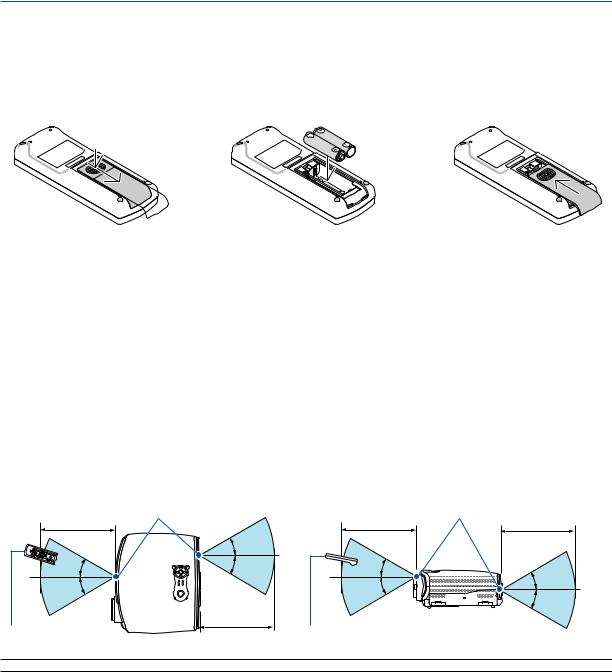
1. Introduction
Battery Installation
1Press firmly and slide the battery cover off.
2Remove both old batteries and install new ones (AAA). Ensure that you have the batteries' polarity (+/–) aligned correctly.
3Slip the cover back over the batteries until it snaps into place. Do not mix different types of batteries or new and old batteries.
Remote Control Precautions
•Handle the remote control carefully.
•If the remote control gets wet, wipe it dry immediately.
•Avoid excessive heat and humidity.
•Do not heat, take apart, or throw batteries into fire.
•Ensure that you have the batteries' polarity (+/-) aligned correctly.
•If you will not be using the remote control for a long time, remove the batteries.
•Do not place the batteries upside down.
•Do not use new and old batteries together, or use different types of batteries together.
•Dispose of used batteries according to your local regulations.
Operating Range for Wireless Remote Control
Horizontal range |
|
Vertical range |
|
|
|
Remote sensor on projector cabinet |
Remote sensor on projector cabinet |
||
7m/22 feet |
|
7m/22 feet |
7m/22 feet |
|
30° |
|
|
30° |
30° |
30° |
30° |
30° |
|
30° |
|
|
30° |
||
|
|
|
|
7m/22 feet
Remote control |
Remote control |
NOTE: The LV-7260 and LV-X7 do not have the remote sensor on the rear panel.
•The infrared signal operates by line-of-sight up to a distance of about 7 m (22 feet) and within a 60-degree angle of the remote sensor on the projector cabinet.
•The projector will not respond if there are objects between the remote control and the sensor, or if strong light falls on the sensor. Weak batteries will also prevent the remote control from properly operating the projector.
10
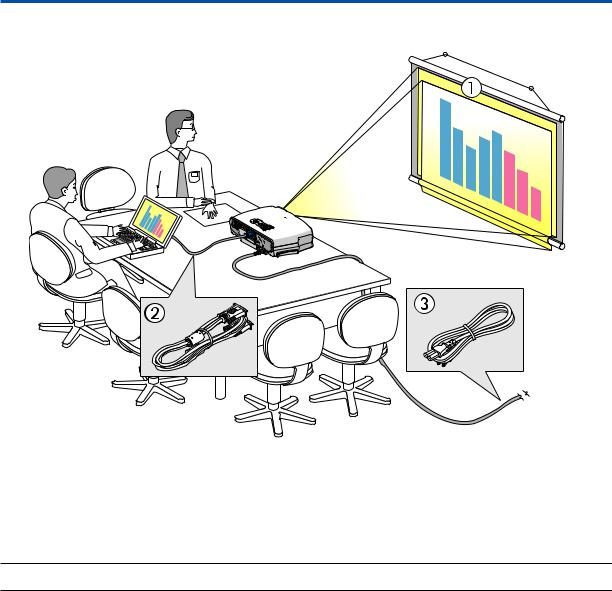
2. Installation and Connections
This section describes how to set up your projector and how to connect video and audio sources.
To the wall outlet.
Your projector is simple to set up and use. But before you get started, you must first:
Set up a screen and the projector. See page 12, 13.
Connect your computer or video equipment to the projector. See pages 15, 16, 17, 18, 19, 20, 21, 22.Connect the supplied power cord. See page 23.
NOTE: Ensure that the power cord and any other cables are disconnected before moving the projector. When moving the projector or when it is not in use, cover the lens with the lens cap.
11

2. Installation and Connections
Setting Up the Screen and the Projector
Selecting a Location (LV-7365/LV-7265)
The further your projector is from the screen or wall, the larger the image. The minimum size the image can be is approximately 25" measured diagonally when the projector is roughly 1.1 m (3.5’) from the wall or screen. The largest the image can be is 300" when the projector is about 8.4 m (27.6’) from the wall or screen. Use the drawing below as a guide.
|
|
|
|
|
|
|
|
|
|
|
|
|
|
|
|
|
|
|
|
|
8.4m |
|
|
|
|
|
|
|
|
|
|
|
|
||
|
|
|
|
|
|
|
|
|
|
|
|
|
|
|
|
|
|
|
|
|
|
|
|
|
|
|
|
|
|
|
|
|
|||
|
|
|
|
|
|
|
|
|
|
|
|
|
|
|
|
|
|
|
|
|
|
|
|
|
|
|
|
|
|
|
|
||||
|
|
|
|
|
|
|
|
|
|
|
|
|
|
|
|
5.6m |
|
|
|
|
|
|
|
|
|
|
|
|
|
|
|
|
|
||
|
|
|
|
|
|
|
|
|
|
|
|
4.2m |
|
|
|
|
|
300" |
|
|
|
|
Zoom (max.) |
|
|
|
|
||||||||
|
|
|
|
|
|
2.2m |
|
|
|
|
|
|
|
|
|
200" |
|
|
|
|
|
|
|
|
|
|
|
|
|
||||||
|
|
|
|
|
|
|
|
|
|
|
|
|
|
|
|
|
|
|
|
|
|
|
|
|
|
|
|
|
|
||||||
|
|
1.1m |
|
|
|
|
|
|
|
80" |
|
|
|
150" |
|
190" |
|
|
|
|
|
|
Zoom (min.) |
|
|
||||||||||
|
|
|
|
|
|
|
|
|
|
|
|
|
128" |
|
|
|
|
|
|
|
|
|
|
|
|
|
|||||||||
|
|
|
|
|
|
|
|
|
|
|
|
|
|
|
|
|
|
|
|
|
|
|
|||||||||||||
|
|
|
|
|
|
|
|
|
|
|
|
|
|
|
|
|
|
|
|
|
|
|
|
|
|
|
|
|
|||||||
|
|
|
|
|
|
|
|
|
|
|
|
|
|
|
|
|
|
|
|
|
|
|
|
H1 |
|
|
|
|
|||||||
|
|
|
|
|
|
40" |
|
|
|
|
|
|
|
|
|
|
|
|
|
|
|
|
|
|
|
|
|
|
|
|
|||||
|
|
|
|
|
|
|
|
|
50" |
|
|
|
96" |
|
|
|
|
|
|
|
|
|
|
|
|
|
|
|
|
||||||
|
|
|
|
|
|
|
|
|
|
|
|
|
|
|
|
|
|
|
|
|
|
|
|
|
|
|
|||||||||
|
|
|
|
|
|
25" |
|
|
|
|
|
|
|
|
|
|
|
|
|
|
|
|
|
|
|
|
|
|
|
|
|
|
|||
|
|
|
|
|
|
|
|
|
|
|
|
|
|
|
|
|
|
|
|
|
|
|
|
|
|
|
|
|
|
|
|
|
|
||
|
|
|
|
|
|
|
|
|
|
|
|
|
|
|
|
|
|
|
|
|
|
|
|
|
|
|
|
|
|
|
|
|
|||
|
|
|
|
|
|
|
|
|
|
|
|
|
|
|
|
|
|
|
|
|
|
|
|
|
|
|
|
|
|
H2 |
|
|
|
|
|
|
|
|
|
|
|
|
|
|
|
|
|
|
|
|
|
|
|
|
|
|
|
|
|
|
|
|
|
|
|
|
|
|
|||
|
|
|
|
|
|
|
|
|
|
|
|
|
|
|
|
|
|
|
|
|
|
|
|
|
|
|
|
|
|
|
|
||||
|
|
|
|
|
|
|
|
|
|
|
|
|
|
|
|
|
|
|
|
|
|
|
|
|
|
|
|
|
|
|
|
||||
|
|
|
|
|
|
|
|
|
|
|
|
|
|
|
|
|
|
|
|
|
|
|
|
|
|
|
|
|
|
|
|
|
|
|
|
|
|
Optional axis when image is projected |
|
|
|
|
|
|
|
|
|
Screen |
|
|
|||||||||||||||||||||
|
|
|
|
|
|
|
|
|
|
|
|
|
|
|
|
|
|
||||||||||||||||||
|
|
at right angle to the screen. |
|
|
|
|
|
|
|
|
|
|
|
|
|
|
|
|
|
|
|
||||||||||||||
Throw Distance and Screen Size |
|
|
|
|
|
|
|
|
|
|
|
|
|
|
|
|
|
|
|
|
|
|
|||||||||||||
|
|
|
|
|
|
|
|
|
|
|
|
|
|
|
|
|
|
|
|||||||||||||||||
Screen size (W×H) cm |
25” |
|
30” |
|
40” |
|
|
60” |
80” |
100” |
150” |
|
|
180” |
200” |
250” |
300” |
||||||||||||||||||
51×38 |
|
61×46 |
|
81×61 |
122×91 |
163×122 |
203×152 |
305×229 |
|
366×206 |
406×305 |
508×381 |
610×457 |
||||||||||||||||||||||
|
|
|
|
|
|||||||||||||||||||||||||||||||
Projection distance |
– |
|
– |
|
1.1m |
1.7m |
2.2m |
2.8m |
4.2m |
|
|
5.0m |
5.6m |
7.0m |
8.4m |
||||||||||||||||||||
Zoom (max) |
|
|
(3.6’) |
(5.4’) |
(7.3’) |
(9.1’) |
(13.7’) |
|
|
(16.5’) |
(18.3’) |
(22.9’) |
(27.6’) |
||||||||||||||||||||||
|
|
|
|
|
|
|
|
|
|
|
|
||||||||||||||||||||||||
Projection distance |
1.1m |
|
1.3m |
|
1.7m |
2.6m |
3.5m |
4.3m |
6.5m |
|
|
7.9m |
– |
– |
– |
||||||||||||||||||||
Zoom (min) |
(3.5’) |
|
(4.2’) |
|
(5.6’) |
(8.5’) |
(11.4’) |
(14.3’) |
(21.4’) |
|
|
(25.8’) |
|||||||||||||||||||||||
|
|
|
|
|
|
|
|
|
|
||||||||||||||||||||||||||
H1 |
32cm |
|
39cm |
|
51cm |
77cm |
103cm |
129cm |
193cm |
|
|
231cm |
257cm |
321cm |
386cm |
||||||||||||||||||||
(1.1’) |
|
(1.3’) |
|
(1.7’) |
(2.5’) |
(3.4’) |
(4.2’) |
(6.3’) |
|
|
(7.6’) |
(8.4’) |
(10.5’) |
(12.7’) |
|||||||||||||||||||||
|
|
|
|
|
|
||||||||||||||||||||||||||||||
H2 |
6cm |
|
7cm |
|
10cm |
14cm |
19cm |
24cm |
36cm |
|
|
43cm |
48cm |
60cm |
71cm |
||||||||||||||||||||
(0.2’) |
|
(0.2’) |
|
(0.3’) |
(0.5’) |
(0.6’) |
(0.8’) |
(1.2’) |
|
|
(1.4’) |
(1.6’) |
(2.0’) |
(2.3’) |
|||||||||||||||||||||
|
|
|
|
|
|
||||||||||||||||||||||||||||||
H1 and H2: H1 is the height of the screen from the intersection of optical axis and screen surface, and H2 is the height of the intersection when an image is projected at right angle to the screen.
12
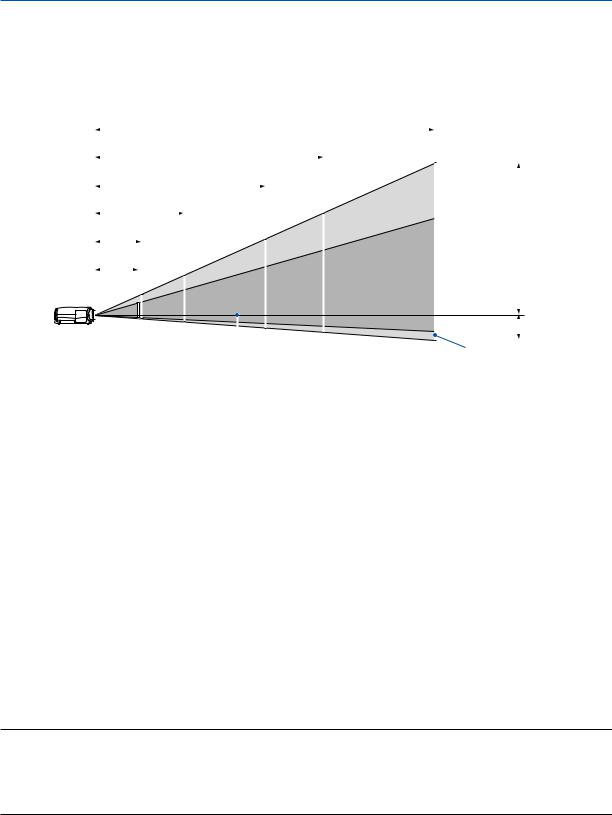
2. Installation and Connections
Selecting a Location (LV-7260/LV-X7)
The further your projector is from the screen or wall, the larger the image. The minimum size the image can be is approximately 25" measured diagonally when the projector is roughly 1.1 m (3.6’) from the wall or screen. The largest the image can be is 300" when the projector is about 8.8 m (28.9’) from the wall or screen. Use the drawing below as a guide.
|
|
|
|
|
|
|
|
|
|
|
|
|
|
8.8m |
|
|
|
|
|
|
|
|
|
|
|
|
|
|
|
|
|
|
|
|
|
|
|
|
|
|
|
|
|
|
|
|
|
||
|
|
|
|
|
|
|
|
|
|
|
5.9m |
|
|
|
|
|
|
|
|
|
|
|
|
|
|
|
|
|
|
|
|
|
4.4m |
|
|
|
300" |
|
|
Zoom (max.) |
|
|
|
|
|||||
|
|
|
|
|
|
|
|
|
|
|
|
|
|
|
|
|
|
|
|
|
|
|||
|
|
|
|
|
2.3m |
|
|
|
|
|
|
200" |
|
|
|
|
|
|
|
|
||||
|
|
|
|
|
|
|
|
|
|
|
|
|
|
|
|
|
|
|
|
|
|
|||
|
|
1.2m |
|
|
|
80" |
|
150" |
190" |
|
|
Zoom (min.) |
|
|
|
|
||||||||
|
|
|
|
|
|
128" |
|
|
|
|
|
|
|
|
||||||||||
|
|
|
|
|
|
|
|
|
|
|
|
|
||||||||||||
|
|
|
|
|
|
|
|
|
|
|
|
|
|
|
|
|
|
|
||||||
|
|
1.1m |
|
|
|
|
|
|
|
|
|
|
|
|
|
H1 |
|
|
|
|||||
|
|
|
40" |
|
|
|
|
96" |
|
|
|
|
|
|
|
|
|
|
|
|||||
|
|
25" |
|
|
50" |
|
|
|
|
|
|
|
|
|
|
|
|
|
|
|||||
|
|
|
26" |
|
|
|
|
|
|
|
|
|
|
|
|
H2 |
|
|
|
|||||
|
|
|
|
|
|
|
|
|
|
|
|
|
|
|
|
|
|
|
|
|
||||
|
|
|
|
|
|
|
|
|
|
|
|
|
|
|
|
|
|
|
|
|
||||
|
|
|
|
|
|
|
|
|
|
|
|
|
|
|
|
|
|
|
|
|
|
|
||
|
|
|
|
|
|
|
|
|
|
|
|
|
|
|
|
|
|
|
|
|
|
|
||
|
|
|
|
|
|
|
|
|
|
|
|
|
|
|
|
|
|
|
|
|
|
|
||
|
|
|
|
|
|
|
|
|
|
|
|
|
|
|
|
|
|
|
|
|
|
|
|
|
|
|
Optional axis when image is projected |
|
|
|
|
|
|
Screen |
|
|
|
||||||||||||
|
|
|
|
|
|
|
|
|
|
|
|
|
||||||||||||
|
|
at right angle to the screen. |
|
|
|
|
|
|
|
|
|
|
|
|
|
|
||||||||
Throw Distance and Screen Size |
|
|
|
|
|
|
|
|
|
|
|
|
|
|
|
|
||||||||
|
|
|
|
|
|
|
|
|
|
|
|
|
|
|
|
|
|
|||||||
Screen size (W x H cm) |
25” |
|
30” |
|
40” |
60” |
80” |
|
100” |
150” |
|
180” |
200” |
|
250” |
300” |
||||||||
51 x 38 |
|
61 x 46 |
|
81 x 61 |
122 x 91 |
163 x 122 |
203 x 152 |
305 x 229 |
366 x 206 |
406 x 305 |
508 x 381 |
610 x 457 |
||||||||||||
|
|
|
|
|
|
|
|
|
|
|
|
|
|
|
|
|
|
|
||||||
Projection distance |
– |
|
– |
|
1.2 m |
1.7 m |
2.3 m |
|
2.9 m |
4.4 m |
|
5.3 m |
5.9 m |
|
7.3 m |
8.8 m |
||||||||
Zoom (max) |
|
|
(3.8’) |
(5.7’) |
(7.7’) |
|
(9.6’) |
(14.4’) |
(17.3’) |
(19.3’) |
|
(24.1) |
(28.9’) |
|||||||||||
|
|
|
|
|
|
|
|
|||||||||||||||||
|
|
|
|
|
|
|
|
|
|
|
|
|
|
|
|
|
|
|||||||
Projection distance |
1.1 m |
|
1.3 m |
|
1.8 m |
2.7 m |
3.6 m |
|
4.6 m |
6.9 m |
|
8.3 m |
– |
|
|
– |
– |
|||||||
Zoom (min) |
(3.6’) |
|
(4.4’) |
|
(5.9’) |
(8.9’) |
(12.0’) |
|
(15.0’) |
(22.5’) |
(27.1’) |
|
|
|||||||||||
|
|
|
|
|
|
|
|
|||||||||||||||||
|
|
|
|
|
|
|
|
|
|
|
|
|
|
|
|
|
||||||||
H1 |
33 cm |
|
39 cm |
|
52 cm |
78 cm |
105 cm |
|
131 cm |
196 cm |
235 cm |
262 cm |
|
327 cm |
392 cm |
|||||||||
(1.1’) |
|
(1.3’) |
|
(1.7’) |
(2.6’) |
(3.4’) |
|
(4.3’) |
(6.4’) |
|
(7.7’) |
(8.6’) |
|
(10.7’) |
(12.9’) |
|||||||||
|
|
|
|
|
|
|
||||||||||||||||||
|
|
|
|
|
|
|
|
|
|
|
|
|
|
|
|
|
||||||||
H2 |
5 cm |
|
6 cm |
|
9 cm |
13 cm |
17 cm |
|
22 cm |
32 cm |
39 cm |
43 cm |
|
54 cm |
65 cm |
|||||||||
(0,2’) |
|
(0.2’) |
|
(0.3’) |
(0.4’) |
(0.6’) |
|
(0.7’) |
(1.1’) |
|
(1.3’) |
(1.4’) |
|
(1.8’) |
(2.1’) |
|||||||||
|
|
|
|
|
|
|
||||||||||||||||||
|
|
|
|
|
|
|
|
|
|
|
|
|
|
|
|
|
|
|
|
|
|
|
|
|
H1 and H2: H1 is the height of the screen from the intersection of optical axis and screen surface, and H2 is the height of the intersection when an image is projected at right angle to the screen.
TIP:
•For the relationship between the screen size and projection distance, see the table on page 69, 70.
•The sizes in the above table have been obtained assuming that the aspect ratio is 4:3. They may vary from the actual sizes depending on the type of the projected image.
•The Zoom lever adjusts the image size (diagonal) +/- 30%.
NOTE:
This projector can be hung from the ceiling (Ceiling mounted) with it turned up side down.
When a translucent screen is used, the projector can project an image from behind the screen (Rear).
When the projector is hung from the ceiling or projector projects an image from behind the screen, the image must be inverted vertically or horizontally. See page 50.
• When hanging the projector from the ceiling, optional brackets (part No. LV-CL11) are required.
13

2. Installation and Connections
WARNING
•Installing your projector on the ceiling must be done by a qualified technician. Contact your dealer for more information.
•Do not attempt to install the projector yourself.
•Only use your projector on a solid, level surface. If the projector falls to the ground, you can be injured and the projector severely damaged.
•Do not use the projector where temperatures vary greatly. The projector must be used at temperatures between 41˚F (5˚C) and 104˚F (40˚C). (Quiet mode selected automatically at 95°F to 104°F/35°C to 40° C).
•Do not expose the projector to moisture, dust, or smoke. This will harm the screen image.
•Ensure that you have adequate ventilation around your projector so heat can dissipate. Do not cover the vents on the side or the front of the projector.
Reflecting the Image
Using a mirror to reflect your projector's image enables you to enjoy a much larger image. Contact your dealer if you need a mirror system. If you're using a mirror system and your image is inverted, use the MENU and SELECT 


 buttons on your projector cabinet or your remote control to correct the orientation. See page 50.
buttons on your projector cabinet or your remote control to correct the orientation. See page 50.
14
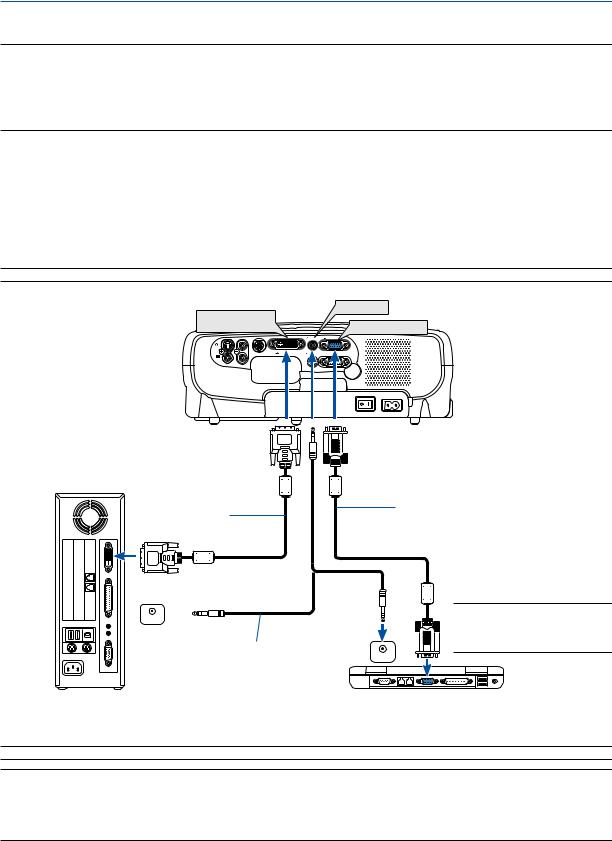
2. Installation and Connections
Making Connections
NOTE: When using with a notebook PC, be sure to connect the projector and notebook PC while the projector is in standby mode and before turning on the power to the notebook PC.
In most cases the output signal from the notebook PC is not turned on unless connected to the projector before being powered up.
*If the screen goes blank while using your remote control, it may be the result of the computer's screen-saver or power management software.
Enabling the computer’s external display
Displaying an image on the notebook PC’s screen does not necessarily mean it outputs a signal to the projector. When using a PC compatible laptop, a combination of function keys will enable/disable the external display. Usually, the combination of the ‘Fn” key along with one of the 12 function keys gets the external display to come on or off. For more details, refer to your computer’s owner’s manual.
Connecting Your PC or Macintosh Computer (LV-7365/LV-7265)
NOTE: The ANALOG IN- 1 connector supports Plug & Play (DDC2).
DIGITAL IN/ |
AUDIO IN |
|
|
||
ANALOG IN-2 |
ANALOG IN-1 |
|
|
|
AUDIO |
S-VIDEO |
L |
|
IN |
|
/ |
|
SERVICE PORT |
-2 |
VIDEO |
R |
IN |
|
|
AUDIO IN |
Use the optional DVI digital cable (LV-CA29) to connect the DIGITAL IN/ANALOG IN-2 connector for a computer with DVI/DVI-I output.
DVI digital cable
(Optional: LV-CA29)
 PHONE
PHONE 
Audio cable (not supplied)
IBM PC or Compatibles (Desktop type) or Macintosh (Desktop type)
VGA cable (supplied)
To mini D-Sub 15-pin connector on the projector. It is recommended that you use a commercially available distribution amplifier if connecting a signal cable longer than the supplied one.
NOTE: For older Macintosh, use a
commercially available pin adapter (not supplied) to connect to your
Mac's video port.
 PHONE
PHONE
IBM VGA or Compatibles (Notebook type) or Macintosh (Notebook type)
NOTE: Use an audio cable without a built-in resistor. Using an audio cable with a built-in resistor turns down the sound.
NOTE: An image may not be displayed correctly when a Video or S-Video source is played back via a commercially available scan converter.
This is because the projector will process a video signal as a computer signal at the default setting. In that case, do the following.
*When an image is displayed with the lower and upper black portion of the screen or a dark image is not displayed correctly: Project an image to fill the screen and then press the AUTO PC button on the remote control or the projector cabinet.
15
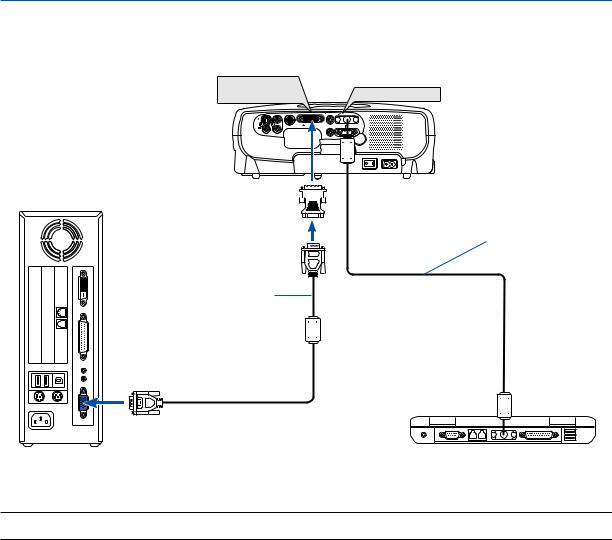
2. Installation and Connections
Using Two Analog COMPUTER Inputs Simultaneously (LV-7365/LV-7265)
If you need to use two analog inputs simultaneously, connect a VGA cable as shown below.
DIGITAL IN / |
ANALOG IN-1 |
|
ANALOG IN-2 |
||
|
|
AUDIO IN ANALOG IN-1 |
S-VIDEO |
L |
|
IN |
|
|
|
SERVICE PORT |
AUDIO OUT |
VIDEO R |
|
|
IN |
|
|
AUDIO IN
DVI to VGA adapter 



(supplied)
VGA cable
(supplied)
VGA cable
(not supplied)
IBM PC or Compatibles (Desktop type) or Macintosh (Desktop type)
IBM VGA or Compatibles (Notebook type) or Macintosh (Notebook type)
NOTE: When the DVI to VGA adapter is not to be used for an extended period of time, remove it from the projector. Failure to do so may cause damage to the connector of the projector.
16
